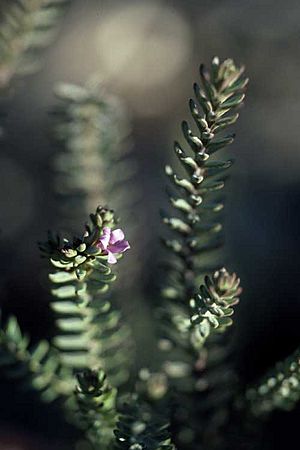Veronica-like eremophila facts for kids
Quick facts for kids Veronica-like eremophila |
|
|---|---|
 |
|
| Conservation status | |
| Scientific classification | |
| Genus: |
Eremophila (plant)
|
| Species: |
veronica
|
| Synonyms | |
|
|
The Eremophila veronica, also known as the veronica-like eremophila, is a beautiful flowering plant. It belongs to the figwort family, which is called Scrophulariaceae. This special plant grows only in Western Australia. It's a small, spreading shrub with tiny leaves and pretty lilac-colored flowers. These flowers have a short tube and petals that spread out.
What it Looks Like
The veronica-like eremophila is a small shrub. It usually grows to be about 20 to 60 cm (8 to 20 in) tall. It can spread out up to 60 cm (20 in) wide. Its branches are quite hairy, and sometimes they feel a bit sticky near the tips.
The leaves on this plant are arranged in groups of three around the branches. They are very close together, almost like they are in neat rows. Each leaf is thin and shaped like a triangle if you cut it. They are small, only 2.5–8 mm (0.1–0.3 in) long and 0.8–2 mm (0.03–0.08 in) wide. The leaves can be green or even a bit purplish. They have tiny hairs and small, dry resin scales.
The flowers grow one by one where the leaves meet the stem. They don't have a stalk. There are five sepals, which are like small leaves that protect the flower bud. These sepals are 2–3.5 mm (0.08–0.1 in) long. The petals are 5.5–7.5 mm (0.2–0.3 in) long. They join together at the bottom to form a tube. The outside of this tube is lilac, and the inside is white with lilac spots. The flower has four stamens, which are the parts that make pollen. They stick out a little from the petal tube.
This plant mainly flowers between October and December. After the flowers, small, oval-shaped fruits grow. They are about 2–3 mm (0.08–0.1 in) long and have a hard outer shell.
Where it Grows
You can find the veronica-like eremophila in the Coolgardie area of Western Australia. It likes to grow in rocky clay soil. You'll often see it in low Eucalyptus woodland areas.
Protecting This Plant
The Western Australian Government's Department of Parks and Wildlife lists Eremophila veronica as "Priority Three". This means we don't know a lot about it, and it's only found in a few places. However, it's not in immediate danger of disappearing. It's important to keep an eye on these plants to make sure they stay safe.
How it's Used
This shrub is a popular plant for gardens because it looks nice. Even when it's not covered in its small, pale blue flowers, it's still an attractive plant. You can grow new plants from cuttings. It grows best in soil that drains water well and in a sunny spot. It doesn't need much water, just a drink during very dry times. It can also handle frost very well.


